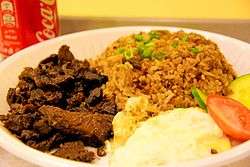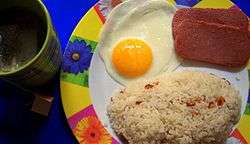Silog
Silog is a class of Filipino breakfast dishes containing sinangag (fried rice) and itlog (egg; in context, fried egg). They are served with various viands or ulam, usually meat dishes such as tapa, longganisa or ham. The name of the accompanying meat dish determines the portmanteau name of the silog; for example, the former three would be known as tapsilog, longsilog, and hamsilog.[2]
 | |
| Type | Breakfast dish |
|---|---|
| Place of origin | Philippines |
| Created by | Vivian del Rosario[1] |
| Main ingredients | Meat, Rice and Egg |
History
The first type of silog to be invented and named as such was the tapsilog. It was originally intended to be quick breakfast fare, and the term was originally established in the 1980s and came from the Tapsi ni Vivian restaurant in Marikina City. According to Vivian del Rosario, owner of Tapsi ni Vivian, she was the first to use the term tapsilog.[1][3]
Due to the popularity of this type of cuisine, some fast food chains in the Philippines and hotels in the Philippines have included silogs on their breakfast menus, and some restaurants only serve this type of dish.[4]
Types of silog
.jpg)

Following the development of tapsilog, many other types of silog have been created, all based around fried rice, or garlic-fried, rice and fried egg, and suffixed with -silog.[5][6] Due to the malleable nature of the dish, basically anything can be silog if served with fried rice and fried egg. Abbreviated examples (in alphabetical order) commonly seen in silog eateries and restaurants include:
- Adosilog – adobo, fried rice and fried egg.
- Bacsilog or baconsilog – bacon, fried rice and fried egg.
- Bangsilog – fried bangus (milkfish), fried rice and fried egg.
- Bisteksilog – beef steak, fried rice and fried egg.
- Daingsilog – daing, fried rice and fried egg.
- Dangsilog – danggit (rabbitfish), fried rice and fried egg.
- Chiksilog or noksilog – fried chicken, fried rice and fried egg.
- Chosilog – chorizo, fried rice and fried egg.
- Cornsilog – corned beef, fried rice and fried egg.
- Hotsilog – hotdog, fried rice and fried egg.
- Litsilog or lechonsilog – lechon or lechon kawali, fried rice and fried egg.
- Longsilog – longganisa, fried rice and fried egg.
- Masilog or malingsilog – Ma-Ling brand Chinese luncheon meat, fried rice and fried egg.
- Porksilog – pork chop, fried rice and fried egg.
- Sisilog - sisig, fried rice and fried egg.
- Spamsilog – Spam brand luncheon meat, fried rice and fried egg.
- Tosilog or tocilog – tocino, fried rice and fried egg.
Beef pares, another common Filipino short-order diner dish, may sometimes be known as "paresilog", "paressilog", etc. if served with a fried egg, since both dishes traditionally include fried rice.
There is a similar dish from Malaysia, the nasi lemak, which is served in a variety of manners using meat, egg and rice with coconut milk.[7]
While a proper silog has sinangag or fried rice, some diners have tried passing off the "si" in silog to stand for sinaing, plain boiled rice, in order to cut costs. Sometimes the boiled rice is topped with fried garlic flakes and passed off as "garlic rice", though the term "garlic rice" is properly understood as fried rice with garlic. More honest places will call this "kalog", from kanin, the general term for cooked rice. It is also possible to come across "plain" or "just" silog which is just fried rice and egg. If one wishes an additional fried egg, the order may sometimes have an additional "log"; i.e., tapsilog with extra egg is "tapsiloglog", etc. and this may be extended ad infinitum.
See also
References
- Rodriguez, Jon Carlos (March 1, 2014). "Meet the Pinay who started the 'tapsilog' craze". ABS-CBN News. Quezon City: ABS-CBN Corporation. Retrieved May 26, 2019.
- "Tapsilog and other Silogs: garlic rice & egg are the ultimate pairing". Glutto digest. Retrieved May 26, 2019.
- Estrella, Serna (March 15, 2019). "A Brief History of the Tapsilog and Its Many Variations". pepper. Retrieved May 26, 2019.
- Amoyan, Christele J. (June 6, 2014). "Bentesilog: Serving popular Pinoy breakfast all day long". Entrepreneur Philippines. Retrieved May 26, 2019.
- "SILOG – VARIATIONS". Tagalog Lang. Retrieved May 26, 2019.
- "Famous Silogs of the Philippines". ChoosePhilippines. August 29, 2013. Retrieved May 26, 2019.
- Michellon, Clémence (January 31, 2019). "Nasi lemak: What is the Malaysian dish and why is it being celebrated?". The Independent. Retrieved May 26, 2019.
